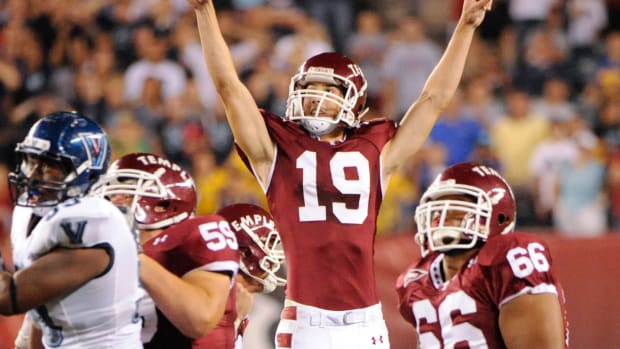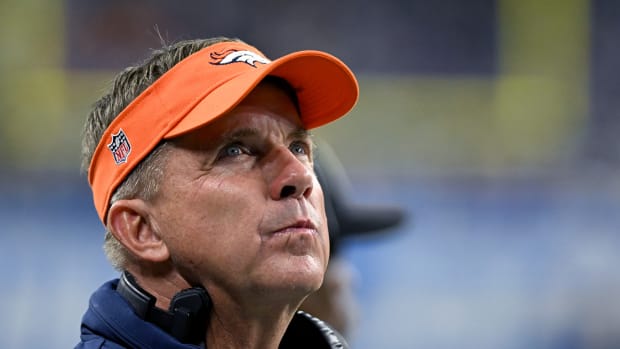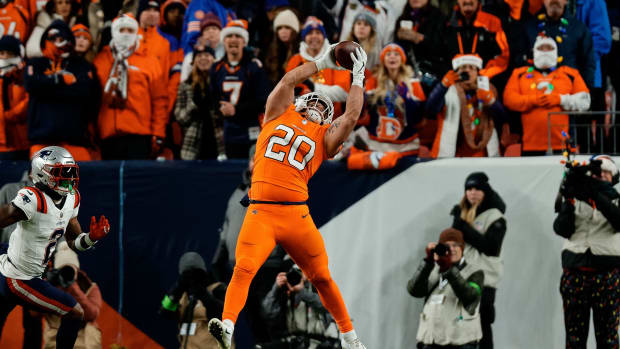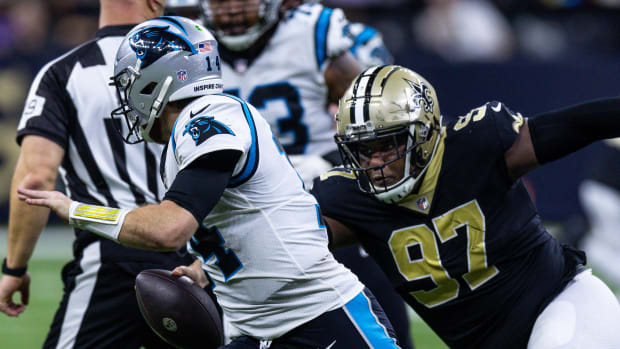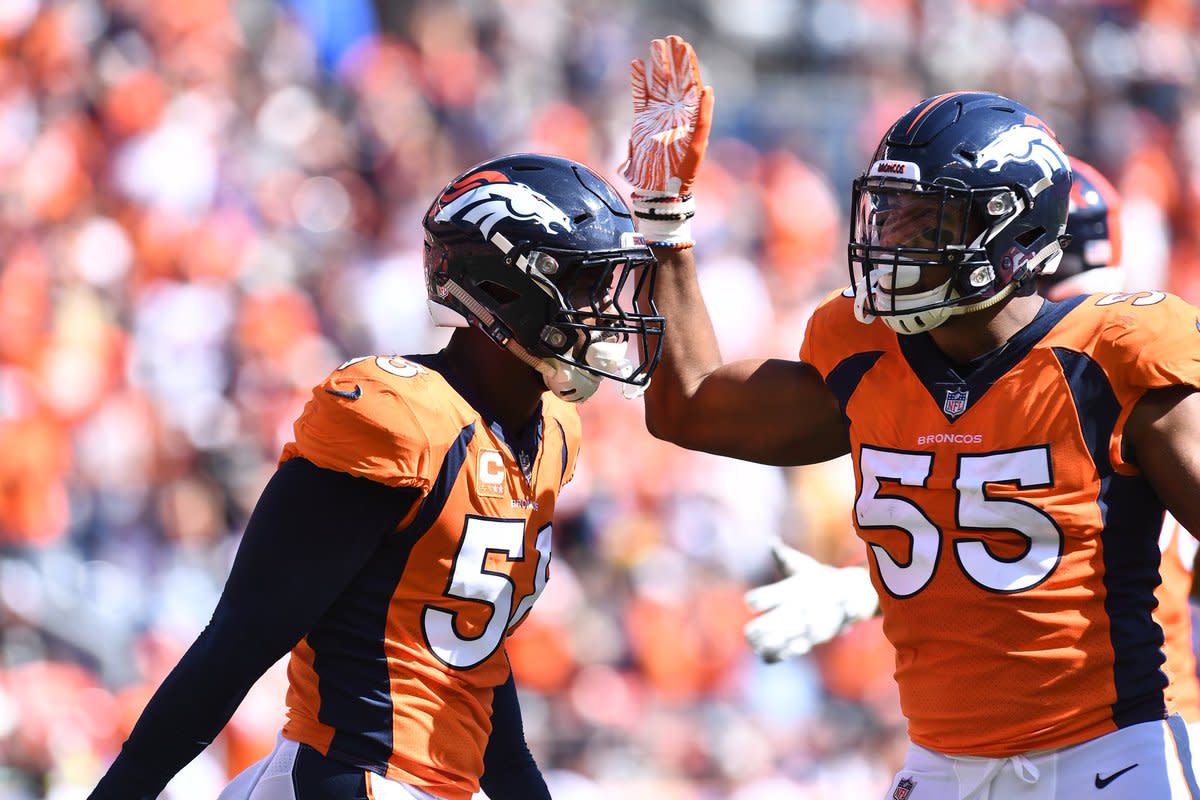
5 problems, 5 solutions to empower the Broncos' pass rush
The Denver Broncos were supposed to have an elite pass rush in 2019. With the likes of perennial All-Pro Von Miller and emerging star Bradley Chubb rushing the quarterback off the edges, along with the talent on defense and the brilliance of Vic Fangio, at the very least the 2019 Broncos were expected to put pressure on the quarterback, rack up hurries, hits, and sacks, and hopefully create turnovers.
On paper, it seemed simple, but two weeks into the season, the pass rush has been disheartening to say the least.
Two games in, the Broncos’ vaunted pass rush has a grand total of zero sacks and zero takeaways. Considering the issues the Broncos have on offense, this is a large reason for the team starting off 0-2.
However, while many will simply look at the stat sheet and claim Chubb and Miller have to do better, the truth is, the Broncos’ struggles to generate game-changing pass rush goes well-beyond the team's dominant edge duo.
There are times that, yes, you would hope your superstar players go out and make a play (Chubb did on Sunday but the refs had something to say about that with a ticky-tack roughing-the-passer flag), but football is hardly so simple. With so many variables going into each snap, from scheme, to game-flow, and to personnel, does the Broncos’ inability to create turnovers and pressures really fall on Chubb and Miller?
Or is it more nuanced than that? Breaking it down and really analyzing what's happened in each of the Broncos' first two games, it’s easy to see why the stats aren’t coming… yet.
Problem 1: Lack of interior pass rush
Anyone who has followed my work over the last season knows how much I had dreams of adding a dominant interior pass rusher to the Broncos' roster in the 2019 draft. With elite talents such as Alabama’s Quinnen Williams, Houston’s Ed Oliver, and Mississippi State’s Jeffery Simmons, it seemed like picking at No. 10 overall (originally), the Broncos were going to have a real chance at securing an elite talent to help rush the passer between Chubb and Von and create real nightmares upfront on defense.
Things didn’t work out that way as Williams went No. 3 overall to the Jets, Oliver went one pick before the Broncos' original selection at No. 9 overall to the Bills, and Simmons suffered an ACL tear that will likely cost him his entire rookie season, knocking him out of the top-10. However, despite this, Simmons still went 19th overall to the Titans, which shows how much talent the league thinks he possesses.
The Broncos did wind up selecting a defensive lineman, but it was in the third round in Ohio State’s Dre’Mont Jones. Jones has flashed pass rush, but he is a player that will likely need a year in the system before making an impact on the field. Expect to see Jones being much more a part of the plan in 2020 than this season.
So that leaves, for the most part, the likes of Shelby Harris, Adam Gotsis, Derek Wolfe, and DeMarcus Walker (and somewhat Mike Purcell but he is a pure run-stuffing nose tackle and won’t bring much in terms of pass rush).
Wolfe had a fantastic game against the Bears, controlling blockers and wrecking gaps, but he isn’t much of a pass rusher anymore. Harris, who has flashed pass-rush ability, seems to be stymied by playing nose in the two-gapping scheme and is miscast as such. He appears to be much better as a sub-package 1-tech or 3-tech, as opposed to the role he is playing now.
Gotsis, while flashing ability, is much more of a long, strong run stopper as well. Walker, while playing better this year, has been such a liability to date and a historic ‘cleanup sack artist’ that the initial pressure ability just isn’t something to expect from him. From the personnel department, it seems the Broncos are stuck with what they have in 2019. However, there are options.
Solution: More blitzes and twists/stunts.
In the second half against the Bears this past week, Vic Fangio deviated from his ideals and started sending pressure via the blitz. If the Broncos' underneath coverage can’t contain the short, quick pass game, then it does make sense to send some blitzers to help create more initial pressure and free up Von and/or Chubb to some one-on-one situations. It isn’t what Fangio would prefer to do based on his comments and past defenses, but it is a solution.
One thing that is perplexing, though, is the lack of twists and stunts from the defensive front. At both San Francisco and Chicago, Fangio’s defense used a variety of pressure looks from their front four to create confusion and mix up offensive linemen and quarterbacks, freeing up rushers with twists and stunts.
So far through the first two weeks in Denver, the number of twists and stunts have been stunningly low. There is likely a reason for this as we will cover next, but it’s worth noting and is a good methodology to help create more fortuitous pass-rushing opportunities going forward.
Problem 2: Not winning on first & second down to create third-&-long
A big issue for the Broncos so far in 2019 has been the defense's inability to help themselves on first and second down. In football, teams ‘earn’ their pass rush reps on third-and-long by playing good defense and executing on first and second down.
However, through the first two weeks of the season, the Broncos' defense has not been able to unleash their pass-rushing potential because the opposing offense has been able to get to third-and-short consistently and stay on schedule.
In Week 1, the Raiders average yards-to-go on third down was 4.14. This improved against the Bears on Week 2, increasing to an average yards-to-go on third down of 7.16 but taking out one third-and-29 as a result of a hold and a negative pass play, that average drops to 5.18 yards to gain on third down for the Broncos' defense.
Denver did improve last week, though, amassing more third-and-longs (7-plus yards) on 6-of-12 third downs as opposed to just 2-of-14 against the Raiders. Some of that, of course, has to do with the opponent as the Bears are rather inept on offense and the Raiders are a bit underrated there, but it still is a step in the right direction.
Winning on first and second down is important because it means the opposing offense will have to be more aggressive in order to convert, sending out more receivers who run longer timing routes and exposing their blockers and quarterback to a higher rate of pressure.
However, on third-and-short, the playbook is wide-open and opponents can run the ball, call a quick pass, or even try to sneak in a big play against the Broncos’ defense. This makes the job for the rushers harder as they can’t simply pin their ears back and hunt, but must play disciplined due to the multiple possibilities of play calls coming from the opponent.
As Chris Harris, Jr. stated, “We have to try and get them in third-and-long, second-and-longs. We have to win first and second down better. That will help us get more pass rush situations.”
Solution: Better open-field tackling, better execution in coverage and run responsibilities.
The Broncos must do a better job in the early downs to open the floodgates and help put their pass rushers in better situations, or expect more of the same from the lack of pressure on the opposing quarterback. The Broncos really did not do this Week 1, but they appeared to be trending in the right direction in Week 2.
This could be due to playing a worse offense and playing at home, but it also is a reasonable assumption that with the new players and new scheme, the team is improving. The Broncos have been losing in the quick pass game, with Derek Carr getting rid of the ball in 2.33 seconds (4th-fastest in the league) and Trubisky throwing it in 2.68 seconds but nearly half his throws coming out in less than two seconds, as well as seeing the Bears utilize a moving pocket to help negate the pass rush.
One simple solution is doing better at rallying to the football and tackling in the open field. In a more zone-heavy scheme than in years past, the onus is on the players to make their open-field tackles. There is a reason Fangio says tackling is "non-negotiable".
The Broncos don’t have the personnel to play the heavy press-man coverage they did in 2015, as it requires elite players in the back seven to pull off, but better open-field tackling will help.
Furthermore, improving against the run is imperative. The team seemed to improve here from Week 1 to 2, but still, the Bears stayed on schedule and marched as needed, controlling the ball just enough to also control the game with little threat from the Broncos' offense.
If the Broncos can do a better job turning those three to five-yard runs into one to two-yarders, things will open up for the pass rush. Hopefully, as the team becomes more immersed and experienced in the new scheme, they will be able to play faster, execute better, and win more consistently on first and second down. Third-and-long is the money down and there simply haven’t been enough of them.
Problem 3: Lack of difference makers in back seven
Another reason for the Broncos' struggles in creating pass rush from Miller and Chubb is, as was hinted at before, the team might lack the studs in the back seven to help negate the run game and pass rush from opposing teams.
The Broncos do not have a bad defense by any means on paper, but this team won’t sniff the likes of its 2015 counterpart that had three man-cover corners in Aqib Talib, Chris Harris, Jr., and even Bradley Roby, with T.J. Ward coming downhill and able to rally to the ball in run support and the short pass game, and the speed of Danny Trevathan and Brandon Marshall in the middle of the defense.
Wade Phillips didn’t employ a very difficult defense schematically, but put his guys in positions to succeed and match up one-on-ones, playing press-man and smothering out the short pass game with talent, not scheme.
That won’t likely be the case this season for the Broncos. Playing a more complex defense, execution, communication, and chemistry becomes paramount and will be needed to help cover up some of the deficiencies in talent. This can be done, but it takes time in such a mentally-demanding defense.
It took Fangio a few seasons in Chicago for his defense to really take shape, so expecting a year-one click might have been unrealistic. The Broncos do have some studs in the back seven, mainly in Chris Harris, Jr. and the flashes from Justin Simmons and Kareem Jackson at safety, but they haven’t shown the quality necessary to negate the quick pass game. However, reinforcements are coming.
Solution: Getting healthy is the best bet.
Through the first two weeks of the season, the Broncos have been without two of their starters on defense in both linebacker Todd Davis and cornerback Bryce Callahan. Perhaps no player has been as misunderstood by the fanbase over the past few seasons as Davis.
While not the fastest sideline-to-sideline and unable to match up in many single-man coverage assignments, Davis has been the brain of the defense as the signal-caller and the muscle in the middle, reading runs well, filling gaps, and shedding blockers as well as any off-ball linebacker in the league.
He has been sorely missed early on, as the play of Corey Nelson has been ‘shield your eyes, kids’ bad through the first two weeks. Perhaps an unfair assessment, given that he was brought in right before the season, but there is a reason Nelson has been cut from three teams since leaving Denver following the 2017 season.
Isaac Yiadom has been somewhat of a disappointment, but also unexpectedly uneven through the first two weeks. As a late third-round selection, coming off shoulder surgery and playing his third defensive scheme in as many years, Yiadom has struggled.
It is not time to give up on the young player as he did improve from Week 1 to 2, but he would be better served as the team’s third corner as he continues to grow in the league. Callahan was brought in for a reason, and it sounds like he is expected to play in Week 3.
Callahan's foot is a concern, but given that he already knows this defense and his quick-twitch ability, he should be a big boost for the depth of the secondary. It’s not the 2015 defense by any means, but the addition of these two players back into the starting lineup could be enough to swing the favor and help the back seven better compliment the pass rush.
Problem 4: Opposing offense playing conservatively due to disrespect of Broncos’ offensive firepower
Perhaps most the most frustrating aspect of watching these games is that opposing offenses are doing a phenomenal job minimizing Denver’s best weapon in their pass rush because, simply put, the opponents seemingly do not respect the Broncos’ offense.
The Broncos' offense has shown some promise out of the gate, moving the ball better, eating up clock by converting first downs, and showing flashes of potential with a better pass game with the somewhat sleeping giant that is the explosive plays from the run game that were shown in 2018. Moving the ball is one thing, punching it in the endzone is quite another.
A long-time concern for the zone-blocking West Coast offense variant under Mike Shanahan and thereafter, Gary Kubiak, was how the offense tended to stall in the red zone. Between the 20's, the offense was able to chew up yards, but once the field became compressed it was harder to punch the ball in to score seven.
In a league that is scoring at an ever-increasing rate, kicking field goals and not crossing the goal line will lose teams games. There are two different reasons the Broncos are struggling to put up points, which then would make opposing offenses be more aggressive and open themselves up for the pass rush:
- A lack of explosive plays
- A lack of execution
The Broncos have not shown the ability yet to create chunk plays on offense. With a real lack of dynamic speed at the wide receiver position outside of the 32-year-old Emmanuel Sanders, and an offensive line struggling in pass protection for their immobile quarterback, scheming explosive pass plays will be relatively hard to do.
Explosive pass plays being few and far between was expected, but sadly, even the explosive rushing offense the Broncos flashed last season has been lacking in the first two weeks.
Due to the inability to create explosive plays on offense, the Broncos must be able to carry out long methodical drives and march down the field. They have been able to get some of these drives started, showing promise, but this requires superb execution.
One penalty, one missed blocking assignment, one missed read, one errant throw, and the Broncos are under threat of stalling out.
Solution: Better execution in opposing territory, more play-action to create downfield pass attempts.
This is easier in writing than actually doing, but given the lack of explosive playmakers in the offense and Joe Flacco being so dependent on his pass protection with little ability to create in broken plays, the Broncos must simply execute better on offense. This may be hard for the team given their propensity to shoot themselves in the foot with holding penalties, but it is the reality of the situation.
It is hard to really complain too much about OC Rich Scangarello and his scheme through just two games, as he is learning about his team and growing himself as a first-time play caller, but perhaps the only complaint is that there have been a surprisingly limited number of play-action passes called through two weeks.
Given the issues in pass protection at tackle, play-action can be risky given the vulnerability of the quarterback, but it is likely Denver's best chance to create explosive plays down the field and gain chunk yards. Even if the Broncos are struggling to run, that does not matter as multiple studies have shown there is zero correlation between the success of play-action and how effective a team is running the ball. So, Denver needs to call play-action passes, call it again, and then call it some more.
The lack of explosive runs is somewhat concerning, but perhaps not shocking given the Broncos’ new scheme in run blocking going to a more zone oriented approach from the power system that brought them so much success last season. The zone scheme requires much more cohesion between the starting five as they must work in unison to succeed.
Given the injuries upfront, all the new pieces, and just installing the new scheme itself, hopefully the explosive plays from the run game are just beyond the horizon for the Broncos’ offense. Until the Broncos can threaten enough on offense to concern opposing teams, then their opponents will continue to play it safe, dink and dunk, go run-heavy, and call a ball control offense because they won’t feel like they need to press to score points.
Problem 5: Fatigue
Perhaps not as much of an issue this early in the season, but my goodness are the starters playing more snaps than they have been used to under their new head coach Vic Fangio. In 2018, Bradley Chubb and Von Miller both accounted for the exact same snap percentage on defense, playing 844 snaps for 78.37% of the available defensive snaps.
Through two games this year, Chubb has accounted for 94.83% of the defensive snaps and Miller with 95.69%. If this were Madden with fatigue turned off, this wouldn’t be an issue, but given how opposing offenses are staying on the field, coverting third downs at a 52% clip through the first two weeks, and seeing many players with their hands on their hips trying to catch their breath, perhaps the high volume of snaps for the defensive studs is taking a toll on their effectiveness.
This may not be a giant issue early in the game, but when the Broncos really need their stud edge rushers to step up late in the fourth quarter or on a third-down money play, where they really must dig deep to make a play, this can be an issue. These are professional athletes at the peak of human conditioning, but they are human and do wear down over time.
Solution: Play more Justin Hollins and Malik Reed.
The Broncos are not afforded the edge depth they have had in previous seasons, back when they had a still engaged Shane Ray and Shaquil Barrett. However, the team does have some edge depth talent that flashed in preseason in Malik Reed and Justin Hollins.
Even though there is an obvious massive dropoff from Chubb and Miller to Reed and Hollins, giving the starters a breather every now and then might be needed to help dig deep at the end and come away with that needed pressure, hit, or sack to change the outcome of the game. There is a reason the phrase ‘you can never have too many pass rushers’ is a cliche.
What it all means
Football is a game of countless variables. Synergy is the name of the game and playing complementary football in all three phases is necessary to win in almost every game. The Broncos do sport a deadly pass rush, and seeing how opponents are game-planning to neutralize them is quite obvious.
From the dink-and-dunk quick pass game, to a higher percentage of run plays, the edge duo is affecting the game because they are limiting how the opponents are attacking the defense.
Their impact hasn’t been enough thus far, though, as the Broncos are still 0-2 and the pass rush has yet to make that game-changing play most have grown accustomed to from Denver. Superficially, just looking at the box score, it’s easy to place blame on Chubb and Von, but breaking down the game and looking at how each part of the team interacts, it's simply a delusion to place the blame solely at their feet.
From the lack of difference makers around them on defense, to the team’s struggles on first and second down, to opposing teams not respecting the Broncos' ability to put up points, to the high percentage of snaps, Chubb and Von have not been allowed to flourish in the first two weeks of the season.
Until these areas improve, the strength of the Broncos’ team will continue to be neutered on Sunday.
Follow Nick on Twitter @NickKendellMHH and @MileHighHuddle.






